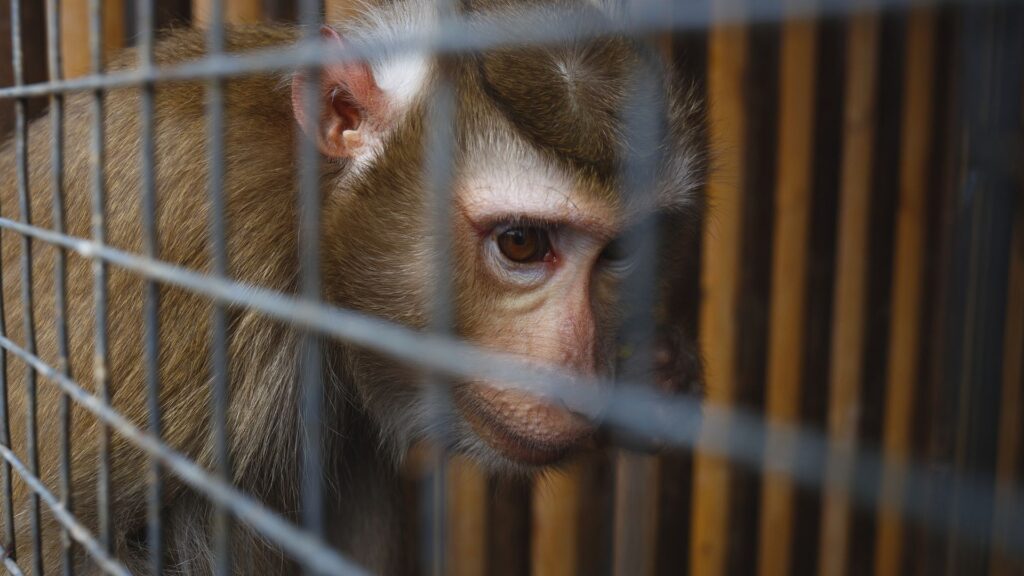Transient visual pathway critical for normal development of primate grasping behaviour (2018). Mundinano, I., Fox, D., Kwan,WC., Vidaurre, D., Teo, L., Homman-Ludiye, J., Goodale, MA., Leopold, DA. And Bourne, JA. Proc Natl Acad Sci USA, Feb 6;115(6):1364-1369. doi: 10.1073/pnas.1717016115.
Associated institutions: Australian Regenerative Medicine Institute, Monash University; Oxford Centre for Human Brain Activity, University of Oxford; The Brain and Mind Institute, University of Western Ontario; Laboratory of Neuropsychology, National Institute of Mental Health, Bethesda.
Background:
This study was funded by the NHMRC and the Victorian Government, and approved by Monash University Animal Ethics Committee. It was aimed to look at the development of the neurological pathway linking vision to guide precise manual movements (ie Eye-hand coordination) in early life.
The Experiment:
Eight marmoset monkeys were used in this experiment. They were sourced from the National Nonhuman Primate Breeding and Research Facility, Churchill, Victoria.
Four neonatal monkeys (aged 14-22 days) received a chemical lesion to a part of the brain (left hemisphere medial subdivision of the inferior pulvinars – PIm). The lesions were induced with the neurotoxin N-methyl-D-aspartate using MRI-guided stereotaxic surgery.
They underwent MRI scans at 6, 9, 18 and 37 weeks to visualise any changes in the brain tissue, then they were allowed to recover until adulthood (18 months).
A further four monkeys, aged between 18 and 22 months, were used as controls.
Marmosets naturally live in family groups of 10-15 individuals, are day-active, and in the wild would inhabit the upper canopy of forested areas. The primates used in this experiment were housed in individual cages measuring 144x75x64cm, with limited access (9am to 5pm) to connected external cages of similar dimension. (It is noted however, that the testing occurred between 10am and 4pm – during the limited time they had access to the external cages.)
The animals were trained to enter a transport box mounted to their cage, then transported to an experimental room which was visually isolated from the vivarium. They were then trained to reach for objects (pieces of banana) positioned in locations to favour reaches from either the left or right arm to eliminate any potential handedness bias. You can view a video of the testing here. (Not graphic)
The monkeys underwent between 10 and 20 trials as their movements, grasp and coordination were all recorded.
At the conclusion of the testing, they were deeply anaesthetised, transcardially perfused and their brains were sectioned for further analysis.
Results:
It was revealed that “the unilateral PIm-lesioned animals had significant bimanual deficits compared with the control group.”
“The capacity to learn such visually guided movements with the dominant hand also was affected by the early lesion. Whereas control animals readily improved their performance on the reach-to-grasp task over multiple repetitions, the lesioned animals exhibited virtually no learning.”
Wasted resources
Aside from the clear ethical dilemma of using animals with high cognitive abilities and well-developed social structures as mere ‘tools for research’, the use of primates has been found to be poorly predictive of human outcomes and their use has proven to be ineffective at providing substantial contributions to biomedical research.
This study, funded by Australian taxpayers, is yet another example of wasting precious resources – studying the wrong species – and a display of blatant disregard for sentient, social and highly-cognitive individuals.
What You Can Do
Please use the form below to tell Monash University how disappointed you are with their use of animals in this experiment. You can use the text provided or compose your own (remember polite personalised messages carry more weight).
Your message will be sent via email to the Executive Assistant of the Vice-Chancellor of Monash University.
"*" indicates required fields
References:
(1) Pound P, Ebrahim S, Sandercock P, Bracken MB, Roberts I; on behalf of the Reviewing Animal Trials Systematically Group. 2004. ‘Where is the evidence that animal research benefits humans?’, BMJ, 328, 514-7.
(2) Perel P, Roberts I, Sena E, Wheble P, Briscoe C, Sandercock P, et al. 2007. ‘Comparison of treatment effects between animal experiments and clinical trials: systemic review’, BMJ, 334:197.
(3) Van der Worp H, Howells DV, Sena ES, Porritt MJ, Rewell S, O”Collins V, et al. 2010. ‘Can animal models of disease reliably inform human studies?’, PLoS Med.

